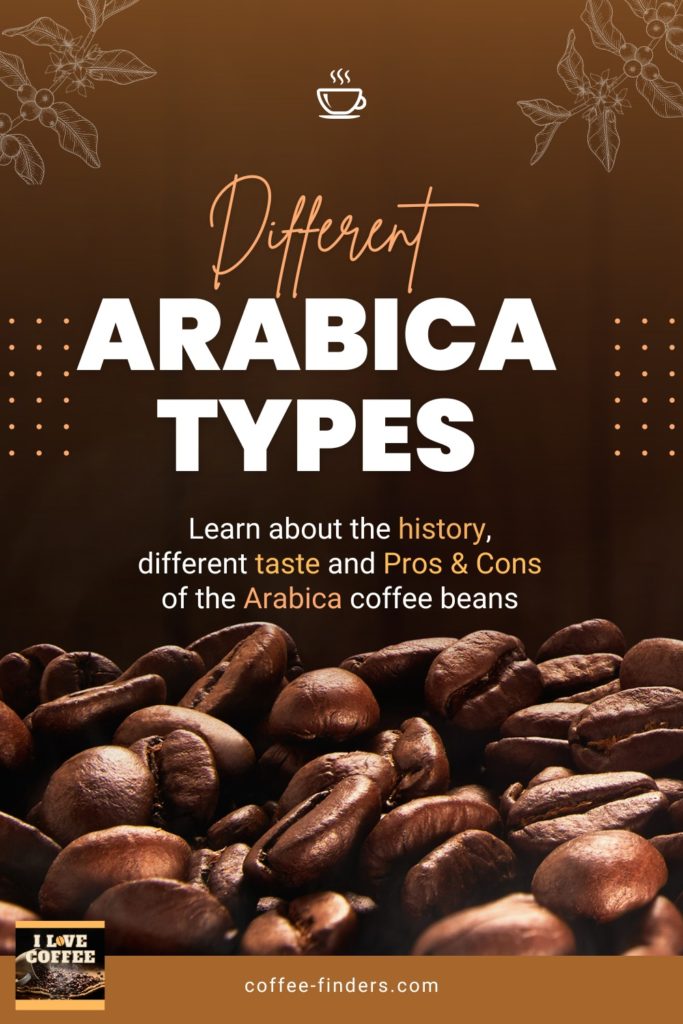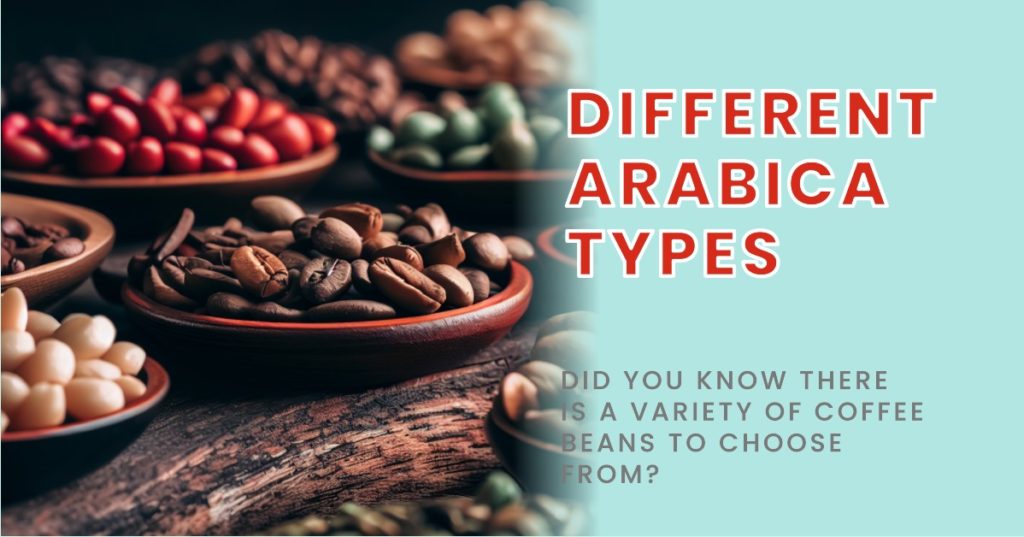Arabica coffee is the most widely consumed type of coffee in the world, accounting for about 60% of the global coffee production. Arabica coffee beans are known for their rich flavor, aroma, and acidity, as well as their diverse genetic diversity.
But did you know that there are many different Arabica types, each with its own history, characteristics, and quality? I didn’t before I came here to Honduras and spoke with some of the coffee farmers. Coffee is coffee, right? Nope! There are hundreds of different Arabica types, each with its own characteristics and history.
| Type | Origin | Flavor Profile | Other Characteristics |
|---|---|---|---|
| The Older Original Types | |||
| Typica | Ethiopia and Yemen | Sweet and clean with low acidity and medium body | One of the oldest and most influential arabica types |
| Bourbon | Bourbon island (now Réunion) | Complex and fruity with high acidity and medium body | Derived from Typica, widely grown in Latin America and Africa |
| Mocha | Yemen | Distinctive with notes of chocolate, wine, and spice. Low acidity and high body | Rare and prized, often blended with other coffees |
| Java | Indonesia | Smooth and earthy with low acidity and high body | Old and popular, often blended with Mocha |
| The Newer Types from 1900 to 1999 | |||
| Gesha | Ethiopia | Delicate and floral with notes of jasmine, bergamot, and honey. High acidity and light body | Rare and exquisite, one of the most expensive coffees in the world |
| SL28 | Kenya | Bright and complex with notes of citrus, berry, and caramel. High acidity and medium body | High-quality and resilient, developed by Scott Laboratories |
| Catimor | Portugal | Mild and nutty with low acidity and medium body | Productive and disease-resistant, a cross between Caturra and Timor |
| Pacamara | El Salvador | Sweet and fruity with notes of chocolate, orange, and pineapple. Medium acidity and full body | Large and unique, a cross between Pacas and Maragogipe |
| The Newest Types from After 2000 | |||
| Anacafe 14 | Guatemala | Balanced with notes of chocolate, caramel, and citrus. Medium acidity and floral aroma | Very high yielding and rust-resistant, developed by ANACAFE |
| Ruiru 11 | Kenya | Rich and full with notes of blackcurrant, grapefruit, and spice. High acidity and heavy body | Robust and disease-resistant, developed by CRF |
| Catisic | El Salvador | Smooth and mild with low acidity and medium body | Adaptive to warm and acidic soils, a type of Catimor |
| IHCAFE 90 | Honduras | Sweet and aromatic with notes of vanilla, almond, and apple. Medium acidity and creamy body | Resistant to leaf rust and nematodes, a type of Catimor |
In this post, we will explore some of the most common and interesting Arabica coffee types, their origins, their advantages and disadvantages, and why new types are being developed. I have divided them into three categories: the older original types, the newer types from 1900 to 1999, and the newest types from after 2000.
Different Arabica Types Table
In this blog post we will look at the following:
What is Arabica Coffee and Why is it So Special?
Arabica coffee is a type of coffee that belongs to the species Coffea arabica, which is native to Ethiopia and Yemen. It is different from other types of coffee such as robusta, which belongs to the species Coffea canephora, and liberica, which belongs to the species Coffea liberica. You see more of this in my post on the topic “coffee history“.

Arabica coffee is so special because it has a superior flavor, aroma, and acidity compared to other types of coffee. Arabica coffee beans have more sugars and oils than robusta or liberica beans, which gives them a more complex and nuanced taste.
Arabica coffee beans also have less caffeine than Robusta or Liberica beans, which makes them less bitter and more acidic.
Arabica coffee is also more difficult to grow than other types of coffee. Arabica coffee plants require a high altitude (between 1,000 and 2,000 meters), a cool climate (between 15 and 24 degrees Celsius), and a lot of shade and moisture.
Arabica coffee plants are also more susceptible to pests and diseases than robusta or Liberica plants. These factors make arabica coffee more rare and expensive than other types of coffee.
Actually, here in Honduras, this is the only coffee bean they are allowed to grow, and this is said to be to protect the quality of the coffee they produce. Here you can read more about one of my coffee tours in Honduras.
Different Arabica Types – What are the Main Varieties of Arabica Coffee?
The Older Original Types
The older original different Arabica types are the ones that have been cultivated for centuries, and are considered the ancestors of most modern Arabica types. They are usually named after their regions of origin, such as Ethiopia, Yemen, or Java. These types have a long and rich history, and have influenced the development of many other types. Some of the most famous older original types are:
- Typica: Typica is one of the oldest and most influential arabica types, originating from Ethiopia and Yemen. It was brought to Indonesia by the Dutch in the 17th century, and then spread to other parts of the world by traders and colonizers. Typica has a sweet and clean flavor with low acidity and medium body. It is often used as a base for coffee blends. Typica is also known as Sumatra, Java, Kona, or Colombian.
- Bourbon: Bourbon is another ancient and important arabica type, derived from Typica. It was first cultivated on the island of Bourbon (now Réunion) in the Indian Ocean by the French in the 18th century, and then introduced to Latin America and Africa. Bourbon has a complex and fruity flavor with high acidity and medium body. It is widely grown in Brazil, Colombia, Rwanda, and El Salvador. Bourbon is also known as French Mission or N39.
- Mocha: Mocha is a rare and prized arabica type, native to Yemen. It was named after the port city of Mocha, where it was exported to Europe and Asia in the 15th and 16th centuries. Mocha has a distinctive flavor with notes of chocolate, wine, and spice. It has low acidity and high body. It is often blended with other coffees to enhance their flavor. Mocha is also known as Arabian Mocha or Yemen Mocha.
- Java: Java is an old and popular arabica type, originating from Indonesia. It was first planted by the Dutch in Java in the 17th century, and then spread to other islands such as Sumatra and Sulawesi. Java has a smooth and earthy flavor with low acidity and high body. It is often blended with Mocha to create the famous Mocha-Java blend. Java is also known as Old Brown Java or Old Government Java.
The Newer Types from 1900 to 1999
The newer types from 1900 to 1999 are the ones that have been developed or discovered in the 20th century, mostly through breeding or mutation. They are usually named after their creators or characteristics, such as Gesha, SL28, or Catimor. These types have a more diverse and innovative flavor profile, and have improved resistance to diseases and pests. Some of the most notable newer types from this period are:
- Gesha: Gesha is a rare and exquisite arabica type, originating from Ethiopia. It was discovered in the Gesha forest in the 1930s, but remained obscure until it was planted in Panama in the 1960s. Gesha has a delicate and floral flavor with notes of jasmine, bergamot, and honey. It has high acidity and light body. It is one of the most expensive coffees in the world.
- SL28: SL28 is a high-quality and resilient arabica type, developed in Kenya by Scott Laboratories in the 1930s. It was created by crossing various Ethiopian varieties with Bourbon and Typica. SL28 has a bright and complex flavor with notes of citrus, berry, and caramel. It has high acidity and medium body. It is widely grown in Kenya and other African countries.
- Catimor: Catimor is a productive and disease-resistant arabica type, developed by Portugal’s Instituto de Investigação Científica Tropical (IICT) in the 1950s. It was created by crossing Caturra (a dwarf mutation of Bourbon) with Timor (a natural hybrid of arabica and robusta). Catimor has a mild and nutty flavor with low acidity and medium body. It is widely grown in Brazil, Vietnam, Indonesia, and Central America.
- Pacamara: Pacamara is a large and unique arabica type, developed in El Salvador by Instituto Salvadoreño de Investigaciones del Café (ISIC) in the 1970s. It was created by crossing Pacas (a dwarf mutation of Bourbon) with Maragogipe (a giant mutation of Typica). Pacamara has a sweet and fruity flavor with notes of chocolate, orange, and pineapple. It has medium acidity and full body. It is mainly grown in El Salvador, Nicaragua, Honduras, and Guatemala.
The Newest Types from After 2000
The newest types from after 2000 are the ones that have been developed or discovered in the 21st century, mostly through genetic engineering or selection. They are usually named after their organizations or codes, such as Anacafe 14, Ruiru 11, or Catisic. These types have a more adaptive and competitive edge, and have increased yield and quality. Some of the most interesting newest types from this era are:
- Anacafe 14: Anacafe 14 is a very high yielding and rust-resistant arabica type, developed in Guatemala by Asociación Nacional del Café (ANACAFE) in 2008. It was created by crossing four different varieties: Catuai, Caturra, Catimor, and Sarchimor. Anacafe 14 has a balanced flavor with notes of chocolate, caramel, and citrus. It has medium acidity and floral aroma. It is widely grown in Guatemala and other Central American countries.
- Ruiru 11*: Ruiru 11 is a robust and disease-resistant arabica type, developed in Kenya by Coffee Research Foundation (CRF) in 1985. It was created by crossing Catimor with SL28 and SL34. Ruiru 11 has a rich and full flavor with notes of blackcurrant, grapefruit, and spice. It has high acidity and heavy body. It is mainly grown in Kenya and other African countries.
- Catisic: Catisic is a type of Catimor that was developed in El Salvador by Fundación Salvadoreña para Investigaciones del Café (PROCAFE) in 2006. It was created to adapt to warm and acidic soils and to produce high yields. Catisic has a smooth and mild flavor with low acidity and medium body. It is widely grown in El Salvador and Guatemala.
- IHCAFE 90*: IHCAFE 90 is a type of Catimor that was developed in Honduras by Instituto Hondureño del Café (IHCAFE) in the 1990s. It was created to resist leaf rust and nematodes and to produce high quality at elevations above 1300 meters. IHCAFE 90 has a sweet and aromatic flavor with notes of vanilla, almond, and apple. It has medium acidity and creamy body. It is widely grown in Honduras and other Central American countries.
*Ruiru 11 and IHCAFE 90 are on the list of the newest types because they were released to the public after 2000, even though they were developed earlier. Ruiru 11 was released in 1985, but it was not widely adopted by Kenyan farmers until the early 2000s, when coffee leaf rust became a serious threat. IHCAFE 90 was developed in the 1990s, but it was not officially registered as a variety until 2009. Therefore, these types are considered as the newest ones in terms of their availability and popularity.
These are just some examples of the new types of arabica coffee that are being developed to cope with the challenges that arabica coffee faces. These new types aim to enhance the production, quality, and diversity of arabica coffee in the world.
All these types are just some examples of the many varieties of arabica coffee that exist in the world. Each variety has its own unique characteristics and flavor profiles that appeal to different palates and preferences.
But again, often this detail is not on your regular bag of coffee. You might need a more high-end brand to find this.
Feel free to Pin the Main Varieties of Arabica Coffee image to find the article later!

Read my Danesi Coffee Beans Review here. This is a really good Arabica coffee choice, especially if you like the Italian coffee style.
What are the Pros and Cons of Different Arabica Varieties?
Different Arabica varieties have different advantages and disadvantages in terms of yield, disease resistance, climate adaptation, quality, and price. Here are some of the pros and cons of some of the main varieties of arabica coffee:
- Typica: This variety has a low yield but a high quality. It is also very susceptible to pests and diseases such as coffee leaf rust and coffee berry borer. It requires a lot of care and attention from the farmers. It is also one of the most expensive varieties of arabica coffee due to its rarity and quality.
- Bourbon: This variety has a higher yield than Typica but a lower quality. It is also more resistant to pests and diseases than Typica, but still vulnerable to some. It adapts well to different climates and altitudes but prefers a moderate temperature and rainfall. It is also more affordable than Typica due to its availability and popularity.
- Caturra: This variety has a very high yield and adaptability. It can grow in various climates and altitudes, from sea level to 2,200 meters. It is also more resistant to pests and diseases than Typica or Bourbon, but still susceptible to some. It has a lower quality and acidity than Typica or Bourbon, but still acceptable for specialty coffee. It is also cheaper than Typica or Bourbon due to its abundance and productivity.
- Catuai: This variety has a similar yield and adaptability as Caturra, but with a slightly higher quality and acidity. It is also more resistant to pests and diseases than Caturra, but still prone to some. It is also cheaper than Typica or Bourbon due to its abundance and productivity.
- Geisha: This variety has a very low yield but a very high quality and price. It is also very sensitive to pests and diseases such as coffee leaf rust and nematodes. It requires a lot of care and attention from the farmers. It is also one of the most expensive varieties of arabica coffee due to its rarity and quality.
- SL28: This variety has a low yield but a very high quality and acidity. It is also very susceptible to pests and diseases such as coffee leaf rust and coffee berry borer. It requires a lot of care and attention from the farmers. It is also one of the most expensive varieties of arabica coffee due to its rarity and quality.
These are just some examples of the pros and cons of different Arabica varieties. Each variety has its own strengths and weaknesses that affect its production, quality, and price. Farmers have to choose the best variety for their specific conditions and preferences.
And to me, it seems some farmers just grow what they always have done, for tradition, and others are more into technology and testing. Speaking of types, in my post What Your Choice Of Coffee Says About You, you can do a coffee personality quiz. Check it out!
Different Arabica Types – Why are New Types of Arabica Coffee Being Developed?
Arabica coffee faces many challenges due to climate change, pests and diseases, deforestation, and rising demand. Climate change affects the temperature, rainfall, humidity, and soil conditions that Arabica coffee plants need to thrive.
Pests and diseases such as coffee leaf rust, coffee berry borer, nematodes, etc., threaten the health and productivity of arabica coffee plants. Deforestation reduces the availability of land, water, shade, and biodiversity that Arabica coffee plants need to grow. Rising demand increases the pressure on farmers to produce more coffee with fewer resources.
To address these challenges, new types of arabica coffee are being developed through various methods such as breeding, hybridization, genetic engineering, etc. These new types aim to combine the best traits of different varieties such as high yield, disease resistance, climate adaptation, quality, etc. This should not be confused with the rise of coffee 2.0.
Conclusion – Different Arabica Types
Arabica coffee is a diverse and fascinating type of coffee that has many different varieties, each with its own history, characteristics, and quality. Arabica coffee is also facing many challenges due to climate change, pests and diseases, deforestation, and rising demand.
To overcome these challenges, new types of arabica coffee are being developed through various methods such as breeding, hybridization, genetic engineering, etc.
I hope this post has helped you learn more about the different types of arabica coffee and why they are important for the coffee industry and culture. If you have any questions or comments, please feel free to leave them below. And if you liked this post, please share it with your friends and fellow coffee lovers. Thank you for reading!

